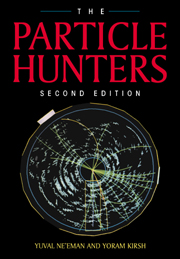Book contents
- Frontmatter
- Contents
- Preface to the first edition
- Preface to the second edition
- 1 The building blocks of the atom
- 2 Physical laws for small particles
- 3 The discoveries of the 1930s and 1940s
- 4 Particle accelerators — or from hunters to farmers
- 5 Strange particles
- 6 Basic forces and the classification of particles
- 7 Conservation laws
- 8 Short-lived particles
- 9 To the quarks — via the eightfold way
- 10 More quarks — or charm, truth and beauty
- 11 The Standard Model and beyond
- Appendix 1 Properties of semi-stable particles
- Appendix 2 The Greek alphabet
- Name index
- Subject index
2 - Physical laws for small particles
Published online by Cambridge University Press: 05 August 2012
- Frontmatter
- Contents
- Preface to the first edition
- Preface to the second edition
- 1 The building blocks of the atom
- 2 Physical laws for small particles
- 3 The discoveries of the 1930s and 1940s
- 4 Particle accelerators — or from hunters to farmers
- 5 Strange particles
- 6 Basic forces and the classification of particles
- 7 Conservation laws
- 8 Short-lived particles
- 9 To the quarks — via the eightfold way
- 10 More quarks — or charm, truth and beauty
- 11 The Standard Model and beyond
- Appendix 1 Properties of semi-stable particles
- Appendix 2 The Greek alphabet
- Name index
- Subject index
Summary
Along with the exciting experiments that changed the face of physics in the twentieth century, work proceeded feverishly on the theoretical side to rebuild the conceptual world that had been severely shaken. Sometimes the theorists lagged behind the experimentalists, and certain experimental results waited for several years to be explained. And sometimes experiment lagged behind theory, and a new theoretical model waited for years to be verified experimentally. Two great theories left their mark on physics in this century: the theory of relativity, and quantum mechanics. In this chapter we shall briefly review the main ideas of these theories which are vital for the understanding of the atomic world.
The theory of relativity
The theory of relativity was formulated by the great physicist Albert Einstein. The first part of it (and the important one for us) — the special theory of relativity — was published in 1905, and sprang from the need to explain a puzzling question that exercised the physicists of the nineteenth century: why was it impossible to alter the speed of light, which remained constant (299 792.5 kilometres per second) even when the detector was moving relative to the source of light? In contrast to other physicists, Einstein did not try to explain this phenomenon.
- Type
- Chapter
- Information
- The Particle Hunters , pp. 28 - 62Publisher: Cambridge University PressPrint publication year: 1996



